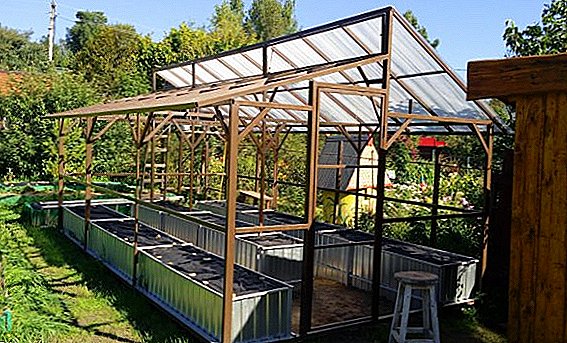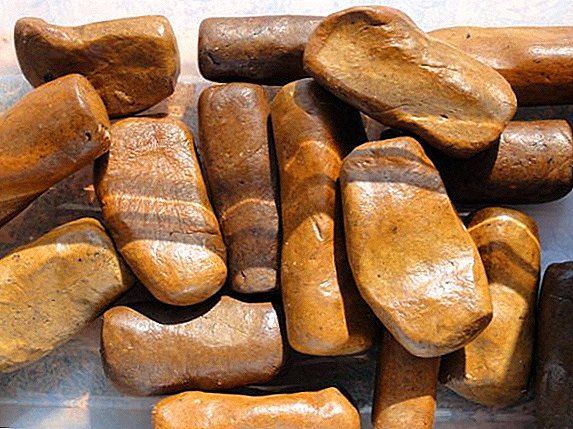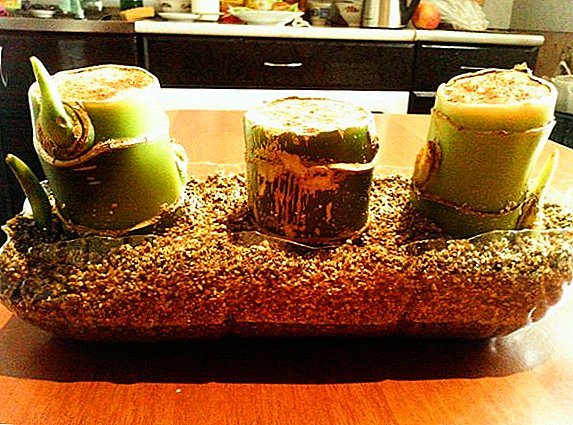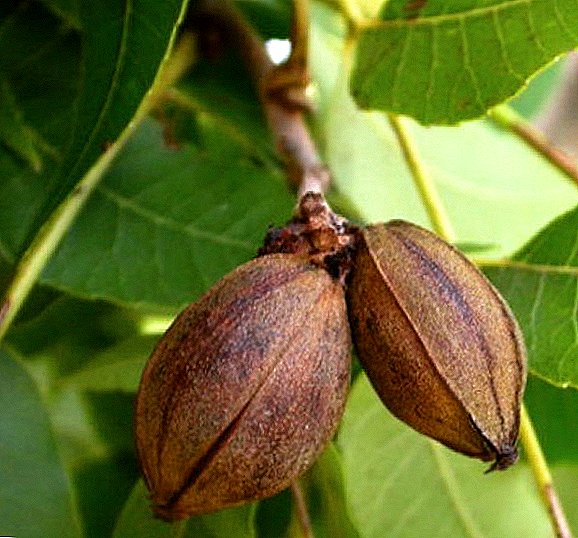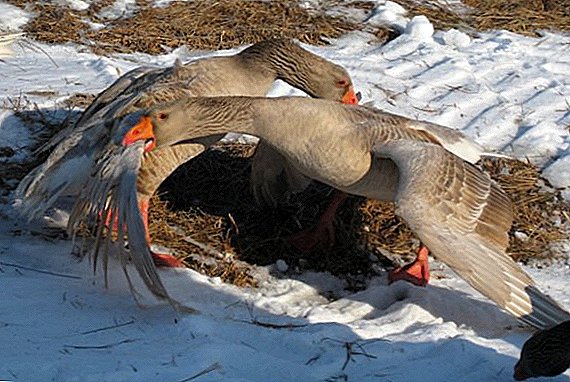 Modern agricultural science seeks to give the farmer the best result as soon as possible, freeing him time for other activities. Thus arose hybrid varieties, unpretentious in cultivation, early and early ripening. One of these champions is the universal hybrid "Miranda", whose qualities have already been tested by time.
Modern agricultural science seeks to give the farmer the best result as soon as possible, freeing him time for other activities. Thus arose hybrid varieties, unpretentious in cultivation, early and early ripening. One of these champions is the universal hybrid "Miranda", whose qualities have already been tested by time.
Variety description
The variety "Miranda" was brought to Moscow more than twenty years ago. In 2003, it was officially listed in the register of the Russian Federation and recommended for cultivation in seven regions (Central Black Earth, Central, North and North-West, Volga-Vyatsky and Middle Volga, as well as the North Caucasus).
This variety is parthenocarpic. This means that the fruits are formed without pollination, and also have no seeds, which makes the vegetable most suitable for greenhouse cultivation. The plant is branched, has strong stems, tall.
Did you know? Cucumber is the oldest vegetable known to mankind for six thousand years. His ancestor is considered to be a liana from the South Asian tropics.The leaves are medium in size, smooth and with smooth edges. Ovaries in one bosom of the leaf can be as many as three. Shrubs have a well-developed root system; the height of one bush reaches 4 m under favorable conditions. There are recommendations for planting density - no more than two plants per square meter.

Rapid growth and high yield make cucumber very attractive for summer residents, especially since this hybrid variety is best grown in small areas. Also, he is not picky about growing conditions and feels good in closed ground.
Get acquainted with the nuances of growing such hybrid varieties of cucumbers as "Claudia", "Herman", "Kibriya", "Berendey", "Aquarius", "Bouquet", "Green Stream", "Ecole", "Merenga", "Buyan" , Crispina, Cupid, Spino, Mamenkin Favorite, Shosh and Moscow Nights.
This makes it available for cultivation even in the northern regions (they usually use the seedling method). The temperature drops are not dangerous for the vegetable, and the weather is bad (the effects of severe frosts are still to be avoided, hybrid varieties do not tolerate this).
After harvesting, the cucumber has a presentation for a whole week, as if it had just been torn off the bed. Miranda is resistant to various diseases, such as powdery mildew, fusarium or olive blotch.  But there are disadvantages even in such a wonderful variety. It is susceptible to bacteriosis - a disease in which the fruit is covered with light brown spots. Young fruits at the same time can be deformed, and then, weakened, be exposed to infection with wet rot.
But there are disadvantages even in such a wonderful variety. It is susceptible to bacteriosis - a disease in which the fruit is covered with light brown spots. Young fruits at the same time can be deformed, and then, weakened, be exposed to infection with wet rot.
The second disadvantage is the fact that not collected on time cucumbers lose their presentation due to the rapid ripening. However, in fairness, we note that this problem is typical of most cucumber varieties.
Fruit characteristics and yield
The cucumber has a cylindrical shape and almost no pronounced ribs. In length, the fruit reaches 11 cm and weighs 100-110 g. One of the advantages of this variety is the lack of bitterness in the fruit, as well as juicy, crunchy flesh. The skin is thick, white streaks are possible.  This variety is not just precocious, but a record holder of precocity! It sprouts within 45 days from the time of planting, and the crop can be harvested after two weeks.
This variety is not just precocious, but a record holder of precocity! It sprouts within 45 days from the time of planting, and the crop can be harvested after two weeks.
Has a high yield - with proper care from 1 square. garden meter can collect 6 kg of cucumbers. The fruits of "Miranda" can be consumed immediately, fresh, and you can prepare for the winter in banks.
Selection of seedlings
Acquire seedlings better in specialized stores or horticultural centers. So there is a guarantee that you will not be deceived with the type of plant. An alternative can be all sorts of garden fairs, where the prices for seedlings are much lower. When buying, ask in detail what soil, what fed seedlings.  When choosing seedlings, pay attention to the condition of the sprouts. They must have strong stems and leaves, as well as a bright green color and healthy appearance. For immediate transplanting into the soil suitable sprouts of three weeks of age.
When choosing seedlings, pay attention to the condition of the sprouts. They must have strong stems and leaves, as well as a bright green color and healthy appearance. For immediate transplanting into the soil suitable sprouts of three weeks of age.
It is still better to buy seeds and grow seedlings yourself. First, this method will cost you less. Secondly, you will know exactly how you grew and fed your cucumbers.
Soil and fertilizer
The most suitable soils are loamy and sandy, necessarily loose, that is light. By acidity, they should be neutral or slightly acidic, with a pH not lower than 7.
We advise you to read about what types of soil exist, how to improve soil fertility, how to independently determine the acidity of the soil at the site, as well as how to deoxidize the soil.
Soil preparation begins in the autumn, when mineral fertilizers are applied to the intended landing site.  In the spring, the earth is dug up to a depth of at least 20 cm. Then, half of the top layer with a rake is mixed with the previously prepared humus. After that, they irrigate and cover the area with a film in order to thoroughly warm the ground before planting the seeds.
In the spring, the earth is dug up to a depth of at least 20 cm. Then, half of the top layer with a rake is mixed with the previously prepared humus. After that, they irrigate and cover the area with a film in order to thoroughly warm the ground before planting the seeds.
The ideal place for planting our hybrid are meadow lands, as the most moisture saturated and nutritious. They can be used in the dacha crop rotation, that is, to take the soil from under the meadow grasses.
It is good to plant cucumber after legumes, after winter rye and wheat. They enrich the soil with nitrogen, and also free up space early, making it possible to prepare it for the next planting.
Growing conditions
Miranda loves good lighting - she needs an open, sunny place. The temperature in the range of 24-28 ° C is optimal. In the 30-degree heat the plant feels not comfortable and suffers from drought.  It is impossible to choose for planting soil cucumbers with surface groundwater. This circumstance will create excessive moisture, and the root system may rot.
It is impossible to choose for planting soil cucumbers with surface groundwater. This circumstance will create excessive moisture, and the root system may rot.
Growing from seed to seedlings at home
This variety of cucumbers can be grown directly from seeds, and you can pre-make seedlings. Experienced gardeners recommend using the second method.
Read more about when the best time to plant cucumbers for seedlings, as well as how to plant cucumbers for seedlings.
Seed preparation
Before sowing seedlings, seeds are prepared:
- warm up within two weeks (the battery or a bright solar window sill will approach);
- sort out seed, removing weak and spoiled seeds;
- pickle;
- washed in clean water.
Video: preparing cucumber seeds for planting For seed dressing, put the seeds in a container and cover it with a powder of disinfectant with thiram (TMTD), shake well and stand for several minutes. This pesticide disinfects planting material, and further protects seeds from mold and root rot.
Content and location
Since the root system of cucumbers is very fragile, seedlings are best sown in separate containers (cups, paper bags). Then these containers are placed in a common box.
Did you know? Cucumbers contain iron and not only increase hemoglobin, but also help purify the blood.
You can buy a ready-made special soil, and you can make a nutrient soil yourself. To do this, take one part of river sand, three parts of peat, the same sod land and humus. On a bucket of this mixture add 5 g of urea, 10 g of superphosphate and 30 g of wood ash.  When the seeds are planted, boxes of seedlings put under the window on the south side or in the greenhouse, covering the film. After the appearance of the first shoots, the film is removed.
When the seeds are planted, boxes of seedlings put under the window on the south side or in the greenhouse, covering the film. After the appearance of the first shoots, the film is removed.
Seed planting process
Capacities for seedlings are filled with soil and organic additives in advance. They are needed to warm up the root system so that cucumbers grow and develop better. Seeds are sown on seedlings for 25 days before the proposed planting in open ground.
In a single cell is placed no more than two seeds. First, they are placed on the surface of the cup with the soil, and then they are sprinkled with the soil for 1.5-2 cm. After this, the place of planting should be slightly sprinkled with warm water. Watering is not necessary so that the seed does not fall further into the soil.
Video: planting cucumber seeds for seedlings Watering is carried out constantly and only with warm water. Boxes are installed so that they constantly fall sunlight. The optimum temperature of seedlings content is not lower than 22 ° С and not higher than 24 ° С.
Important! If you rarely water cucumbers, the fruit may appear bitterness.
Seedling care
Within a week after planting, the first shoots appear. Heat and light conditions during this period are especially important, so do not forget about direct sunlight. Abundant watering continues. If the plants fall into a shaded place and stay there at least a week, the tender shoots will try to reach for the light, become thin, long and weak.
If the weather is cloudy for a long time and there is not enough sunlight, you can send a lamp to the seedlings. The main thing is that 10 hours a day the plants receive their portion of light and heat.  After 30 days, sprouts give from three to six leaves, which means that it is time to transplant them into a greenhouse or an open garden. This is usually the end of May, when the soil is heated to at least 15 ° C.
After 30 days, sprouts give from three to six leaves, which means that it is time to transplant them into a greenhouse or an open garden. This is usually the end of May, when the soil is heated to at least 15 ° C.
Transplanting seedlings to ground
Whatever you choose, outdoor or greenhouse, the soil must be prepared. It is loosened, saturating with oxygen, and also fertilized. For better aeration, sawdust or leaves can be added to the soil.
Seedlings must be carefully removed from the containers in order not to damage the fragile roots. Transplanted seedlings waddle - moving the plant along with an earthy ball into the prepared hole.
If you make a trellis with a cucumber, then the density of planting should not exceed two plants per 1 square. m. If you sit on the spread, the density is allowed a little higher - 3-4 plants per 1 square. m  The landing pattern is as follows:
The landing pattern is as follows:
- the distance between the beds is 0.2 m;
- distance between rows - 0.5 m.
This scheme, firstly, allows you to have convenient access to the beds for harvesting, and secondly, promotes good air circulation. Thick planting can cause undesirable moisture to accumulate, and various diseases will appear on the leaves due to dampness.
Important! The plant is not afraid of temperature drops in the range of 5-10 ° C.
Shrubs "Miranda" feel great at temperatures from 22 ° C to 27 ° C, but the heat at 30 ° C can already have a negative impact on their development and yield.
Video: transplanting cucumber seedlings into the ground
Agrotechnics growing seeds in open ground
Parthenocarpic hybrid cucumbers have one feature - you will not receive seeds for planting from overripe fruits. We'll have to go to specialized stores every time.
It is best to buy seeds in the winter, and only from reputable, proven producers. They will describe in detail the features of the variety you choose, as well as the conditions of its content.
Find out when it is best to plant cucumbers in the open ground.
Outdoor conditions
Seeds of "Miranda" can be planted in open ground in the garden, and in the greenhouse. Greenhouse is preferable because this variety was created specifically for this type of cultivation. It is only important to comply with the technology and necessarily ventilate the room.  The place of planting cucumbers in an open garden should be sufficiently sunny, not shaded, especially in the central and northern regions. In the southern part of the country, the possibility of light shading for several hours per day is allowed. You should not plant a vegetable in the lowlands or holes, where moisture will flow, and cold air will also begin to linger.
The place of planting cucumbers in an open garden should be sufficiently sunny, not shaded, especially in the central and northern regions. In the southern part of the country, the possibility of light shading for several hours per day is allowed. You should not plant a vegetable in the lowlands or holes, where moisture will flow, and cold air will also begin to linger.
Choose places that are at least partially protected from strong winds (for example, behind buildings or near trees). The wind dries the soil and reduces air humidity.
The process of planting seeds in the ground
Around the end of May, it is possible to plant seeds directly into the ground: the main thing is that the soil has already been heated to at least 15 ° C. Disembarkation is carried out according to the scheme 50x50 (distance between seeds and beds). The seed is dipped into a hole 2-3 cm deep.
Video: planting cucumber seeds in open ground
Watering
Watering after planting seeds is carried out daily, gradually increasing the interval. In good, not dry weather, cucumbers are watered every three days. If it rains, watering is not required. If the weather is too hot and the soil dries quickly, then daily watering is allowed.
Water cucumbers preferably in the evening, when the sun will not reduce your efforts to nothing.
Important! Water should be warm and separated, therefore, preparations for irrigation should be made in advance.
Soil loosening and weeding
In order for the root system to grow, and moisture in the soil to remain, the plant stems must be spudded. With regard to loosening, then in this matter should be careful, given the depth of landing.  The nearest root is only 5 cm from the top layer of the soil and it is easy to damage them, causing damage to the entire plant. The same goes for weeding. Sometimes it is better to collect weeds by hand than to risk.
The nearest root is only 5 cm from the top layer of the soil and it is easy to damage them, causing damage to the entire plant. The same goes for weeding. Sometimes it is better to collect weeds by hand than to risk.
If you are able to accurately calculate everything, then it is even useful to loosen the soil between the rows to a depth of 4 cm. This is done after rain or abundant watering so that evaporating water does not form a crust blocking the access of air to the roots. As a tool serve a rake, hoes or other devices, at your discretion.
Masking
Since the variety "Miranda" refers to the early maturity and not pollinated, the special need for pasynkovanii does not arise.
It will be useful for you to read about when and how to stick cucumbers.
Specialists, in any case, do not give any recommendations on this matter.  If you are worried about your plants and are worried if they will not go up to the detriment of yield, you can blind the first three or four nodes of the whips.
If you are worried about your plants and are worried if they will not go up to the detriment of yield, you can blind the first three or four nodes of the whips.
Important! This should be done on time, when the stepchildren are 3-6 cm long. At a later time, the procedure is not effective.
Garter
Given the branching of the plant, the best way to grow is to create a trellis. Towards the middle of June, when young bushes are already strong enough, they are tied up with vertically stretched ropes so that they grow upwards.
The stalk is wrapped with twine a little higher than the cotyledons and is tied with a neat, not tight knot. Later, as the stem grows, it is carefully guided, wrapped around the rope. Such a greenhouse looks neat and beautiful, and access to the harvest and the process of care is much easier.
Video: cucumber garter In the open garden set the grid with large cells, which allowed the growing stems. This method not only saves space and gives support to thin stems - it contributes to a better growth and development of the bush, and consequently, high yields.
Top dressing
Miranda cucumbers need regular feeding in order for the root system to get the necessary minerals and nutrients from the soil (for example, calcium). The frequency of the procedure is once every two weeks. In this case, fertilizers must be alternated: first, mineral, then organic, after them - complex.
Important! Root top dressing good for a warm summer. In cloudy weather it is better to spray the leaves.
Mineral top dressing option:
- for the roots - 10 g of urea and 60 g of superphosphate dissolved in 10 liters of water;
- for leaves - 20 g of superphosphate per 10 liters of water.
 Organic fertilizer:
Organic fertilizer:- for roots - 250 g of ash per 10 liters of water;
- for leaves - refined hay is poured with water in a ratio of one to one, infused for 2 days.
We advise you to read about how to feed cucumbers after planting in the ground and during flowering and fruiting.
Feeding is carried out in the evening, immediately after a good moisture. You can also do this on a cloudy day after a heavy rain. It is very important not to burn the leaves, so fertilizers pour watering can directly into the hole, without spraying, or in the free space between the bushes.
Pests, diseases and prevention
Cucumber hybrids are highly resistant to diseases and infections. But still, slugs and parasites become a problem, especially in wet weather, and a bacterial infection, better known as “angular spotting,” can even hit such sturdy animals.
It is better not to wait for the attack of pests and viruses, but to spray the trellis in advance, before the ovaries form. The most effective measure to date are chemicals - pesticides.  On their packages there is always a detailed instruction on how often and in what quantity to use the product. Follow this instruction carefully and systematically.
On their packages there is always a detailed instruction on how often and in what quantity to use the product. Follow this instruction carefully and systematically.
Harvesting and storage
Crop harvested immediately upon reaching the desired size of greens (in our case it is 10-11 cm). During the period of active ripening of fruits, cucumbers are harvested at least once a day so that they do not ripen and give an opportunity to grow new.
When picking cucumbers, it is very important not to tear them. This way you injure the stems. It is better to take a garden shears and gently cut a ripe vegetable. It is necessary to separate the cucumber so that the stem remains in place. You also can not twist the whips in the harvest process.
Harvesting is carried out in the morning or in the evening, immediately folding the green leaves into a shade. Fresh vegetables are stored for a short time, and the Miranda hybrid, even in the refrigerator, will not last longer than a week.  However, there are some tricks. For example, you can cut the cucumbers together with the stalk and put them in a container with water with these legs down.There should be very little water and it should be changed regularly (at least once every few days). This method will prolong the life of vegetables for a good week and a half.
However, there are some tricks. For example, you can cut the cucumbers together with the stalk and put them in a container with water with these legs down.There should be very little water and it should be changed regularly (at least once every few days). This method will prolong the life of vegetables for a good week and a half.
Did you know? If the cucumber is well washed, spread with egg white and let it dry a little, then you can do without a refrigerator and even without a cellar.
Wrapped in polyethylene, cucumbers will live five days longer than their fixed deadline.
Possible problems and recommendations
With insufficient watering, cucumbers can grow small and crooked. If at the same time they are exposed to high temperatures (above 30 ° C), there is a risk of yellow spots on the leaves and on the cucumbers themselves, which reduces their attractiveness for goods.  Therefore, give watering and hilling the maximum of your attention. Over the years, the Miranda variety has proven its high qualities again and again. Its cultivation is available even to a novice gardener.
Therefore, give watering and hilling the maximum of your attention. Over the years, the Miranda variety has proven its high qualities again and again. Its cultivation is available even to a novice gardener.
All the conditions for this are - specialized soils, seeds, packaging with ready-made fertilizers. One thing remains the same at all times: work must be enjoyable. Then you will receive both a harvest and pleasant impressions.


